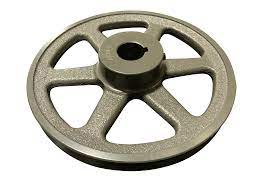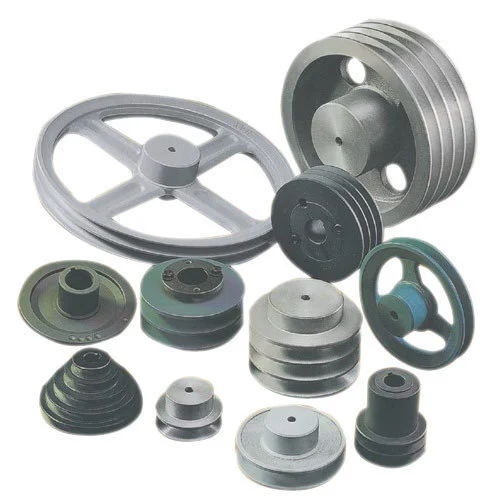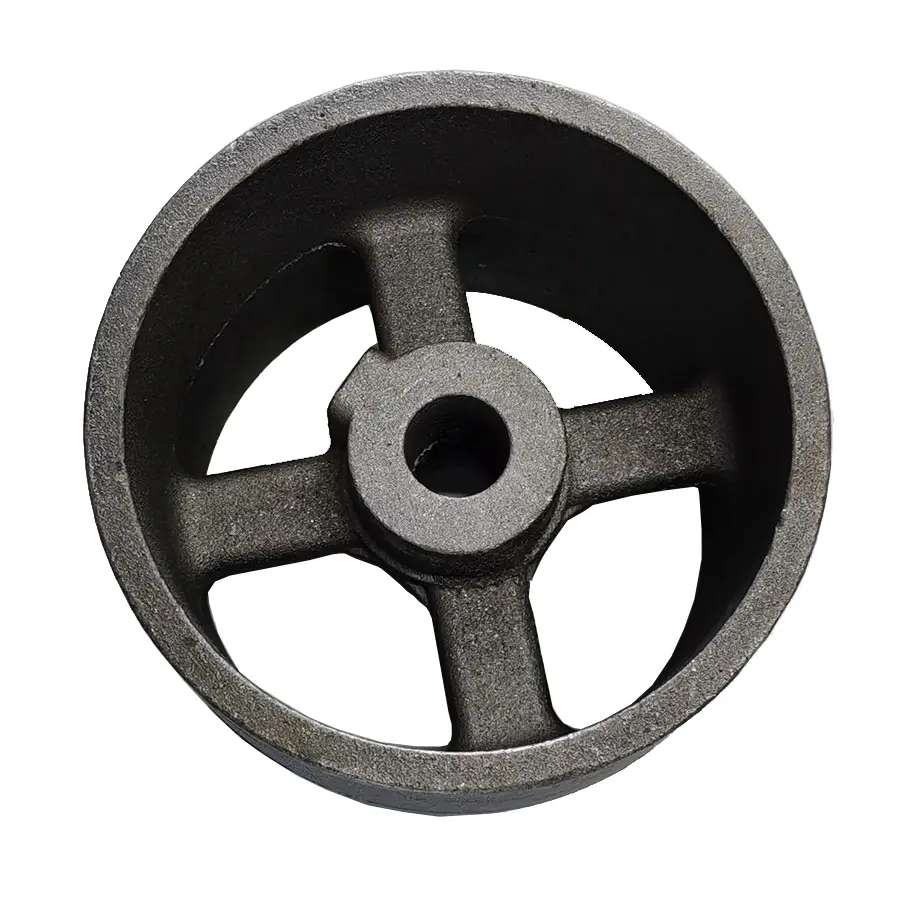Product Description
Groove v-belt cast iron sheave belt pulley
V belt pulley specifications
· European standards :
a) V-belt pulley for taper bushing: SPZ, SPA, SPB, SPC
b) Adjustable speed V-belt pulleys and variable speed pulleys
c) Flat belt pulleys and conveyor belt pulleys
| 500 – 1 x SPZ – 2517 | Taper-v-belt pulley |
| 50 – 2 x SPZ – 1008 rü 26 | Taper-v-belt pulley |
| 56 – 2 x SPZ – 1108 rü 26 | Taper-v-belt pulley |
| 60 – 2 x SPZ – 1108 rü 26 | Taper-v-belt pulley |
| 63 – 2 x SPZ – 1108 bü | Taper-v-belt pulley |
| 67 – 2 x SPZ – 1108 bü | Taper-v-belt pulley |
| 71 – 2 x SPZ – 1108 | Taper-v-belt pulley |
| 75 – 2 x SPZ – 1210 bü | Taper-v-belt pulley |
| 80 – 2 x SPZ – 1210 bü | Taper-v-belt pulley |
| 85 – 2 x SPZ – 1610 bü | Taper-v-belt pulley |
| 90 – 2 x SPZ – 1610 bü | Taper-v-belt pulley |
| 95 – 2 x SPZ – 1610 bü | Taper-v-belt pulley |
| 100 – 2 x SPZ – 1610 bü | Taper-v-belt pulley |
| 106 – 2 x SPZ – 1610 bü | Taper-v-belt pulley |
| 112 – 2 x SPZ – 1610 bü | Taper-v-belt pulley |
| 118 – 2 x SPZ – 1610 bü | Taper-v-belt pulley |
| 125 – 2 x SPZ – 1610 bü | Taper-v-belt pulley |
| 132 – 2 x SPZ – 1610 bü | Taper-v-belt pulley |
| 140 – 2 x SPZ – 1610 bü | Taper-v-belt pulley |
| 150 – 2 x SPZ – 2012 bü | Taper-v-belt pulley |
| 160 – 2 x SPZ – 2012 bü | Taper-v-belt pulley |
| 170 – 2 x SPZ – 2012 bü | Taper-v-belt pulley |
| 180 – 2 x SPZ – 2012 bü | Taper-v-belt pulley |
| 190 – 2 x SPZ – 2012 bü | Taper-v-belt pulley |
| 200 – 2 x SPZ – 2012 bü | Taper-v-belt pulley |
| SPB-1 | ||||||
| PULLEY MODEL | TAPER BUSH | WEIGHT | F | R | L | P |
| SPB100-1 | 1610 | 0.9 | 25 | 25 | ||
| SPB106-1 | 1610 | 1.1 | 25 | 25 | ||
| SPB112-1 | 1610 | 1.2 | 25 | 25 | ||
| SPB118-1 | 1610 | 1.3 | 25 | 25 | ||
| SPB125-1 | 1610 | 1.5 | 25 | 25 | ||
| SPB132-1 | 1610 | 1.7 | 25 | 25 | ||
| SPB140-1 | 1610 | 1.8 | 25 | 25 | ||
| SPB150-1 | 1610 | 2.1 | 25 | 25 | ||
| SPB160-1 | 1610 | 2.5 | 25 | 25 | ||
| SPB170-1 | 1610 | 2.9 | 25 | 25 | ||
| SPB180-1 | 1610 | 3.2 | 25 | 25 | ||
| SPB190-1 | 2012 | 3.8 | 25 | 32 | 3.5 | |
| SPB200-1 | 2012 | 4.2 | 25 | 32 | 3.5 | |
| SPB212-1 | 2012 | 4.3 | 25 | 32 | 3.5 | |
| SPB224-1 | 2012 | 4.7 | 25 | 32 | 3.5 | |
| SPB236-1 | 2012 | 5.1 | 25 | 32 | 3.5 | |
| SPB250-1 | 2012 | 5.7 | 25 | 32 | 3.5 | |
| SPB280-1 | 2012 | 6 | 25 | 32 | 3.5 | |
| SPB300-1 | 2012 | 7.1 | 25 | 32 | 7 | |
| SPB315-1 | 2012 | 7.5 | 25 | 32 | 3.5 | |
FAQ
1.Q: What is your Trade term ?
A: FOB HangZhou Or HangZhou port
2.Q: Can you offer OEM ?
A: Yes , OEM are always welcomed . Please emial us relevant information .
3.Q: Can I get some samples before placing order ?
A: Yes, We will offer 1-2 pcs samples free of charge . Due to different situation , some samples will be charged . If you need further information about our sample policy , please contact us .
4.Q: What is your MOQ ?
A: MOQ of most our products is 1000 pcs , different items maybe different .
5.Q: How can you ensure the quality inspection?
A: On the order process,we have inspection standard before delivery and will supply you the pictures.
6. Q: What about the lead time for mass production ?
A: It depends on the order quantity and the season you place the order . In general , our lead time is about 15~25 days , depends on products
Our service :
Sample service:
-We provide free samples for our existing products range.
-Sample and tooling charges need if special design needed, the exact charges depends on your final design and product.
-We will return sample charges to you once place an order, and return the tooling charges once the order quantity reach to certain quantity.
-It will take 2-3days for free samples.
Customized services:
– We provide OEM and ODM process Service, also Provide product sketch.
After-sale services:
– For most of our products, we provide one year warranty.If any items broken for unartificial reason, we can replace the items after having the approve. We guarantee your satisfaction with all our merchandise. The feedbacks will be paid more attentions from customers constant, we will solve the problems timely.
/* January 22, 2571 19:08:37 */!function(){function s(e,r){var a,o={};try{e&&e.split(“,”).forEach(function(e,t){e&&(a=e.match(/(.*?):(.*)$/))&&1
| Certification: | ISO |
|---|---|
| Pulley Sizes: | OEM |
| Manufacturing Process: | Casting |
| Material: | Iron |
| Surface Treatment: | Polishing |
| Application: | Chemical Industry, Grain Transport, Mining Transport, Power Plant, OEM |
| Samples: |
US$ 50/Piece
1 Piece(Min.Order) | |
|---|
| Customization: |
Available
| Customized Request |
|---|
Can cast iron pulleys be used in HVAC systems and air conditioning units?
Yes, cast iron pulleys can be used in HVAC systems and air conditioning units. They are commonly utilized in various components and mechanisms within these systems. Here’s a detailed explanation of how cast iron pulleys can be used in HVAC systems and air conditioning units:
- Belt Drive Systems: Many HVAC systems and air conditioning units rely on belt drive systems to transfer power from electric motors to various components such as fans, blowers, and compressors. Cast iron pulleys are frequently employed in these belt drive systems. They provide the necessary rotational motion and torque transfer between the motor shaft and the driven components. The robustness and durability of cast iron make them suitable for handling the demands of HVAC applications.
- Tensioning Mechanisms: Proper tensioning of belts is crucial in HVAC systems to ensure efficient power transmission and prevent belt slippage. Cast iron pulleys are often used in tensioning mechanisms to maintain the desired tension in the belts. Tensioning pulleys with adjustable positions or different diameters can be employed to achieve the optimal tension. The stability and strength of cast iron pulleys contribute to maintaining consistent belt tension, resulting in reliable and efficient operation of the HVAC system.
- Fan and Blower Assemblies: Fans and blowers are essential components in HVAC systems and air conditioning units, responsible for circulating air and facilitating heat exchange. Cast iron pulleys are commonly found in fan and blower assemblies. They are used to drive the fan blades or impellers, providing the necessary rotational motion to generate airflow. Cast iron pulleys offer the strength and stability required to withstand the forces associated with fan operation and maintain the desired rotational speed.
- Compressor Systems: Compressors are integral to air conditioning units, as they are responsible for compressing and circulating refrigerant. Cast iron pulleys can be used in the compressor systems of air conditioning units. They transmit power from the motor to the compressor, enabling the compression process. The durability and wear resistance of cast iron pulleys make them suitable for handling the high loads and pressures involved in compressor operation.
- Bearing Support: Cast iron pulleys can also provide support for bearings used in HVAC systems and air conditioning units. They serve as the mounting point for bearings that support rotating shafts, ensuring smooth and stable operation. Cast iron pulleys offer the necessary rigidity and support, minimizing shaft deflection and reducing the risk of premature bearing wear or failure. This helps to extend the lifespan of the bearings and improve the overall reliability of the HVAC system.
- Vibration Damping: Vibrations can be a concern in HVAC systems, as they can lead to noise, discomfort, and potential damage to components. Cast iron pulleys, known for their inherent damping properties, help reduce vibrations in the system. The weight and rigidity of cast iron absorb and dissipate vibrations, contributing to quieter operation and increased comfort. Additionally, reduced vibrations can help prolong the lifespan of other components by minimizing wear and stress on the system.
In summary, cast iron pulleys are commonly used in HVAC systems and air conditioning units for various purposes such as driving belt systems, tensioning belts, powering fans and blowers, driving compressors, providing bearing support, and reducing vibrations. The strength, durability, and vibration-damping properties of cast iron pulleys make them suitable for withstanding the demands of HVAC applications and ensuring reliable and efficient operation.
How do cast iron pulleys handle variations in load capacity and speed?
Cast iron pulleys are designed to effectively handle variations in load capacity and speed, offering reliable power transmission in machinery and mechanical systems. Their construction and characteristics allow them to adapt to different operating conditions. Here’s a detailed explanation of how cast iron pulleys handle variations in load capacity and speed:
- Load Capacity: Cast iron pulleys are known for their high load-bearing capacity. The material composition and structural design of cast iron pulleys enable them to handle heavy loads without deformation or failure. When subjected to varying load capacities, cast iron pulleys distribute the load evenly across their surfaces, minimizing stress concentration and ensuring efficient power transmission. This capability makes cast iron pulleys suitable for applications that involve fluctuating or high loads.
- Speed Variation: Cast iron pulleys can accommodate variations in speed effectively. The pulley’s diameter and groove configuration play a crucial role in determining the speed ratio between the driving and driven components. By selecting the appropriate pulley size and groove arrangement, the speed of power transmission can be adjusted to meet specific requirements. Cast iron pulleys can handle both high-speed and low-speed applications, providing reliable power transmission across a wide range of operating speeds.
- Belt Selection: The choice of belt type and size is another factor that allows cast iron pulleys to handle load capacity and speed variations. Different types of belts, such as V-belts, flat belts, or timing belts, have varying load-carrying capacities and speed capabilities. Cast iron pulleys can be paired with the appropriate belt based on the specific application requirements. The selection of the right belt ensures optimal power transmission and allows the cast iron pulley to handle variations in load capacity and speed effectively.
- Pulley Configuration: Cast iron pulleys are available in a variety of configurations, such as single groove, multi-groove, stepped, or variable speed pulleys. These different configurations allow for flexibility in power transmission systems, enabling adjustments to load capacity and speed variations. For example, multi-groove pulleys provide the option to use multiple belts, distributing the load across several grooves and increasing load capacity. Stepped or variable speed pulleys allow for stepwise or continuous speed adjustments, accommodating changes in operating conditions.
- Engineering Considerations: Proper engineering and design considerations play a crucial role in ensuring that cast iron pulleys handle variations in load capacity and speed effectively. Factors such as calculating the appropriate pulley size, selecting the right belt type, ensuring proper alignment, and considering dynamic factors like torque and inertia are essential for optimizing power transmission performance. By taking these factors into account, engineers can design power transmission systems that maximize the capabilities of cast iron pulleys under varying load and speed conditions.
In summary, cast iron pulleys handle variations in load capacity and speed through their inherent strength, adaptable pulley configurations, suitable belt selection, and proper engineering considerations. Their ability to distribute loads evenly, accommodate different operating speeds, and work in conjunction with compatible belts makes them reliable components for power transmission, ensuring efficient and effective performance in machinery and mechanical systems.
Can you explain the typical applications of cast iron pulleys in machinery?
A cast iron pulley finds widespread use in a variety of machinery and mechanical systems due to its unique characteristics and capabilities. Its strength, durability, and heat resistance make it well-suited for numerous applications where reliable power transmission is essential. Here’s a detailed explanation of the typical applications of cast iron pulleys in machinery:
- Industrial Machinery: Cast iron pulleys are commonly employed in industrial machinery, such as conveyor systems, manufacturing equipment, and material handling systems. These pulleys facilitate the movement of materials, products, or components, often in demanding and heavy-duty environments. Their robust construction and ability to handle substantial loads make them suitable for applications where reliable power transmission is crucial.
- Automotive Systems: Cast iron pulleys are used in various automotive systems, including engines, power steering systems, and air conditioning systems. In engine applications, cast iron pulleys are often utilized in the serpentine belt system to drive various engine accessories, such as the alternator, water pump, and power steering pump. The heat resistance and durability of cast iron make it an ideal material for withstanding the demanding conditions under the hood.
- Agricultural Machinery: Cast iron pulleys play a significant role in agricultural machinery, such as tractors, harvesters, and irrigation systems. These pulleys are utilized in power transmission systems to drive components like belts, chains, and gears, enabling the efficient operation of agricultural equipment. The ability of cast iron pulleys to endure heavy loads and resist wear and tear makes them well-suited for the demanding conditions encountered in agricultural applications.
- Woodworking Machinery: Cast iron pulleys are commonly used in woodworking machinery, such as table saws, planers, and lathes. They are employed in power transmission systems to drive cutting blades, feed rollers, and other moving parts. The stability and vibration-dampening properties of cast iron contribute to the accuracy and smooth operation of woodworking equipment, ensuring precise cuts and consistent performance.
- Mining Equipment: Cast iron pulleys are utilized in mining equipment, including crushers, conveyors, and ore processing machinery. These pulleys are responsible for transmitting power to move heavy loads of materials in mining operations. The robust construction and high load-bearing capacity of cast iron pulleys make them suitable for the demanding and harsh conditions found in mining environments.
- Pumping Systems: Cast iron pulleys are commonly found in pumping systems used for water supply, wastewater management, and industrial applications. They are employed in pumps to transfer power from electric motors or engines to drive impellers or other pumping mechanisms. Cast iron pulleys provide the necessary strength and durability to handle the continuous operation and heavy loads associated with pumping systems.
- Exercise Equipment: Cast iron pulleys are also utilized in various types of exercise equipment, such as weight machines, cable systems, and resistance training equipment. These pulleys enable the smooth and controlled movement of cables or belts, providing resistance or assistance during exercises. The durability and stability of cast iron pulleys contribute to the longevity and reliability of exercise equipment in commercial gyms or home fitness setups.
In summary, cast iron pulleys find typical applications in a wide range of machinery, including industrial machinery, automotive systems, agricultural machinery, woodworking machinery, mining equipment, pumping systems, and exercise equipment. Their strength, durability, heat resistance, and ability to handle heavy loads make them indispensable for reliable power transmission in various industries and mechanical systems.
editor by CX
2024-05-02




